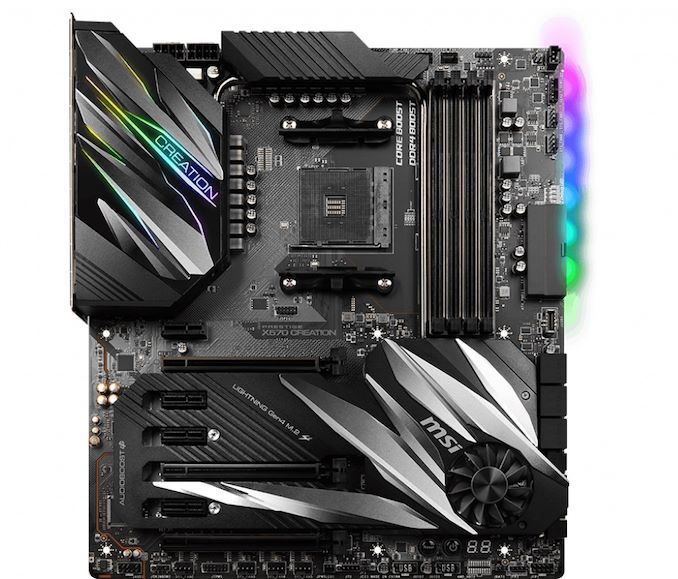The AMD X570 Motherboard Overview: Over 35+ Motherboards Analyzed
by Gavin Bonshor on July 9, 2019 8:00 AM ESTMSI Prestige X570 Creation
The MSI Prestige X570 Creation is designed with content creators and enthusiasts in mind with similar aesthetics to its HEDT counterpart, the MSI X399 Creation, and implements them onto an E-ATX sized consumer desktop model. On the rear panel cover is a funky RGB enabled design, with the creation logo being the centrepiece. This covers the large power delivery heatsink which features an extended design from around the MOSFETs, down the side of the memory slots and into the chipset heatsink. The X570 chipset heatsink also includes a cooling fan, while the two M.2 heatsinks are moulded into the board's design.
Across the PCI area is a PCB cover which gives the X570 Creation a premium look as it also blends into the aesthetic of the chipset heatsink. Included is three full-length PCIe 4.0 slots which run at x16, x8/x8, and x8/x8/x4 as well as four PCIe 4.0 x1 slots. This means that the X570 Creation supports up to three-way AMD CrossFire, and two-way NVIDIA SLI multi-graphics card configurations. The MSI Prestige X570 Creation is using a 14+2 power delivery with two 8-pin 12 V ATX CPU power inputs, and a single 24-pin 12 V ATX motherboard power input designed to power the board. Storage options include two PCIe 4.0 x4 M.2 slots, with six SATA ports. In the top-right hand corner are four memory slots with support for DDR4-4600, and up to 128 GB.
MSI's Prestige X570 Creation has one of the most impressive rear panels for USB 3.1 Gen2 connectivity. The X570 Creation has eleven USB 3.1 Gen2 Type-A, and a single USB 3.1 Gen2 Type-C port. There's also two USB 2.0 ports and a PS/2 combo port. Also included are two Ethernet ports with one controlled by a 10 GbE Aquantia AQC107 NIC, with the other being controlled by an Intel I211-AT Gigabit NIC; also featured is an Intel AX200 Wi-Fi 6 wireless interface. The board's onboard audio is handled by a Realtek ALC1220 HD audio codec which gives users five 3.5 mm audio jacks and a S/PDIF optical output on the rear panel.
The MSI Prestige X570 Creation represents more elegant range directed towards content creators and professional users. Although this model is the only E-ATX sized offering from MSI at present on X570, the rear panel includes the most impressive selection of USB 3.1 G2 Type-A ports of any model on the chipset with a total of twelve; eleven Type-A and one Type-C. This coupled with a 14+2 phase power delivery, support for DDR4-4533, and an MSRP of $499, this could be the most attractive of all the higher-end X570 models at launch.












225 Comments
View All Comments
abufrejoval - Tuesday, July 9, 2019 - link
It's amazing how quickly you run out of PCIe lanes, when you don't have switches to multiplex and translate between PCIe revisions and lanes (e.g. PCIe v4 x2 <-> PCIe v2 x8).I find myself using USB 3.x NBase-T NICs and NVMe adapters, simply because they *do* switch.
Bensam123 - Tuesday, July 9, 2019 - link
Maybe a bit more depth on the power delivery page. I have absolutely no idea how to go about parsing what's there. More chokes is better? What denotes a power phase?A5 - Tuesday, July 9, 2019 - link
+1. Some analysis of that information would be helpful.MrSpadge - Tuesday, July 9, 2019 - link
+1bunkle - Wednesday, July 10, 2019 - link
The controller column includes the total number of phases supported split between CPU cores and SoC e.g. (6+1) = 6 CPU phase and 1 SoC phase. More is *usually* better but has diminishing returns regarding tighter and tighter voltage regulation. Some controllers are better than others (can operate at high frequency e.g. 500KHz v 1000KHz, include other features to improve performance) mitigating the need for more phases.Each phase is a buck converter comprised of a low/high side MOSFET (can be integrated in a single package) and choke. Some controllers can support doubling up the PWM signal to driver more MOSFETs. Doublers can also be added as discrete components if not built into the controller.
Current rating of the MOSFET (e.g. Sic639=40A IR3555=60A) indicates the total power deliverable. MOSFETs are not 100% efficient and vary in efficiency. The more current they provide the hotter they get and the less efficient they become, with better MOSFETs producing less heat for a given current. Thus using doubles can improve temperatures and efficiency without the benefits of the tighter voltage tolerance that *real* phases provide.
Hope that’s helpful!
bunkle - Wednesday, July 10, 2019 - link
A lot more detailed explanation: https://en.wikichip.org/wiki/voltage_regulator_mod...bug77 - Tuesday, July 9, 2019 - link
The description for AsRock X570(M) Pro4 says "5 jack + 1 SPDIF". Unfortunately, those boards lack SPDIF and only come with 3 jacks ;)Smell This - Tuesday, July 9, 2019 - link
I'm thinking the *ASRock Thunderbolt AIC* ...https://thunderbolttechnology.net/product/asrock-t...
would cover all your TBT peripheral needs, including optical.
DanNeely - Tuesday, July 9, 2019 - link
Do X570 boards still need an extra chip per USB port to support USB-C reversibility?The additional expense and needed PCB space were cited as among the reasons why earlier generation boards (IIRC both Intel and AMD) almost never had more than 1 C port; but it was never clear to me if that was an inherent implementation penalty for the C port or an artifact of Intel's tech stack being stalled out and AMD outsourcing to ASMedia which built the chipsets on an ancient (55nm) platform.
DigitalFreak - Tuesday, July 9, 2019 - link
Gavin - X370 and X470 only supported PCIe 2.0. The connection between the CPU and chipset was 3.0, but all the ports on the chipset were 2.0.